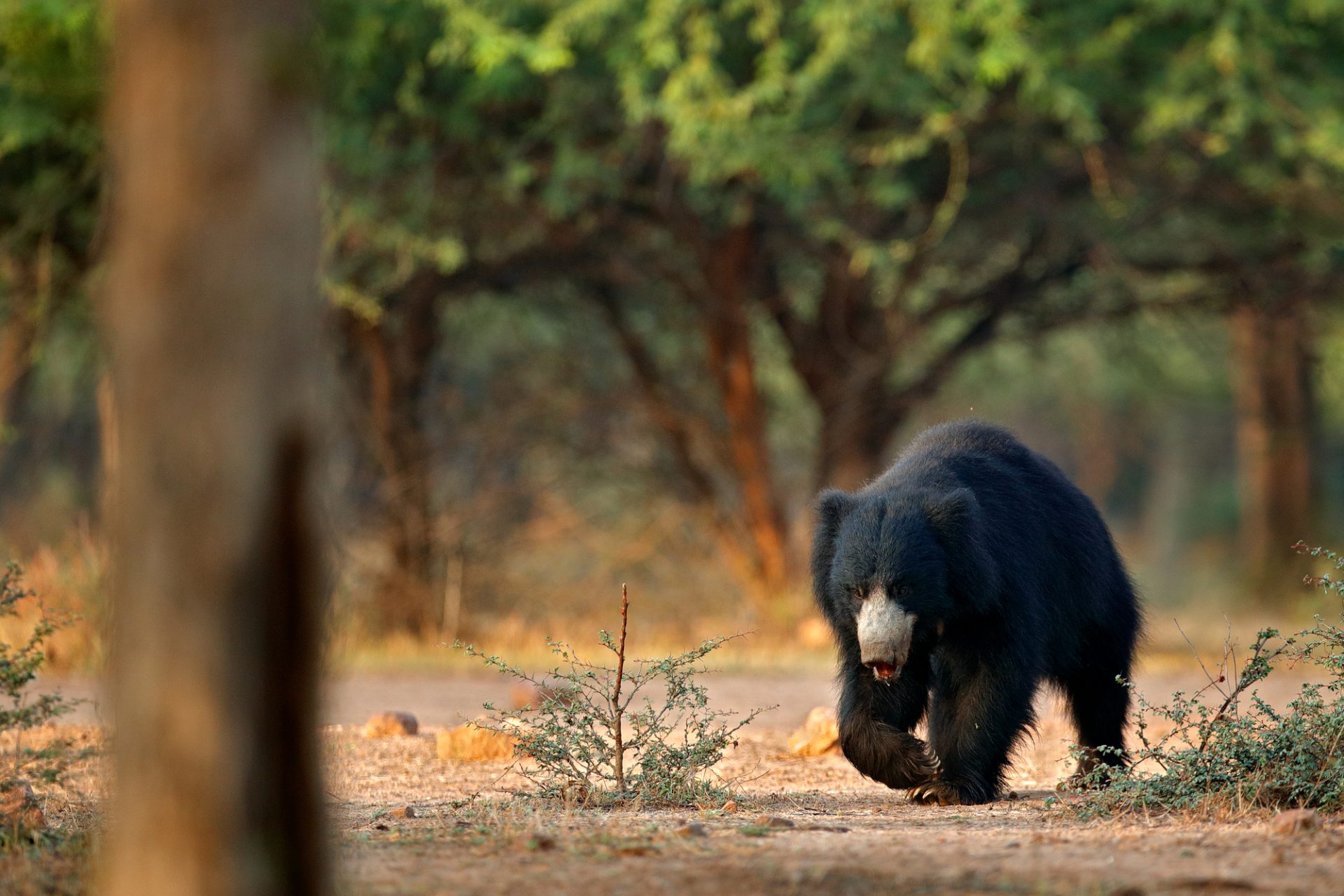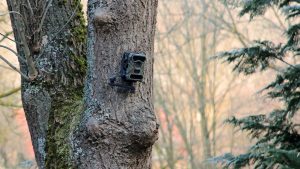If you purchase an independently reviewed item through our site, we earn an affiliate commission. Read our affiliate disclosure.
Among the many predatory animals that are bad news for honeybees, bears rank quite high. Whether a grizzly or black bear, honeybees do not look forward to the day a bear visits their beehive. At best, the bear gets to the brood quickly and eats their fill and then leaves the beehive. In most cases however, a honeybee colony is lost when a bear attacks a beehive. While the bear eats honey, its main target is usually the larvae in the brood chambers. The high protein content of larvae and honeybee eggs makes them prime targets for bears. This article looks at how bears damage beehives and the honeybee colonies in them. It also shares tips on how to protect honeybees from bears.
The Bears and the Bees
Bears build up fat in their bodies before winter. They also eat a lot after coming out of winter hibernation. Spring and autumn are the main seasons for this feeding activity for bears. They go for sugary foods when they can get them. The smell of honey in beehives can attract bears from some distance away. They have also learned to attack beehives due to the presence of bees going in and out. In the wild, bears will go rummaging through beehives in tree hollows. The sugar in honey and high protein content of honeybee larva and eggs, are the attractants of bears to beehives.
How Bears Affect Beehives
1. Damage to Equipment and Honeybees
Typically, a bear visiting a beehive or apiary causes damage to the equipment used in beekeeping, damages structures inside the beehive and can cause the death of many adult bees. This is in addition to destroying a lot of bee brood and eating honey in the beehive. Losses from a single bear visit can hurt your beekeeping activities quite much.
2. Loss of Productivity
The colony that is attacked by a bear has its comb damaged so it has to draw comb afresh. Honeybee population in the colony is also affected. It drops soon after the bear attack due to loss of larvae.
3. Lost Colony
Honeybee colonies suffering a bear attack have a difficult time recovering. When the queen bee is hurt or killed in the attack, the colony is easily lost if you do not intervene.
Honeybees’ Defense Against Bears
When under threat, particularly from a bear, honeybees will fight back. They have stingers on the rear ends of their abdomens. Worker bees can use their stings only once. They die after stinging because their stingers have barbs at the tip. The barbs cause the stinger and attached venom sac to tear from the worker bee abdomen, as it tries to fly off after stinging a threat to the beehive. Queen bees do not have barbs on their stingers. They can therefore sting beehive threats repeatedly.
Drone bees are male and do not have stingers. In a bear attack, it’s up to the female worker bees to sting the threat and protect the beehive. However, bears have thick skin and fur covering most parts of their bodies. Only their face is not covered in this thick skin and fur. They have been observed to endure numerous bee stings to the face, just to reach honey and larvae in beehives.
Do Beehives Attract Bears?
Both insects and animals use various senses to find food, water, mates and other important things around them. They also depend on their senses for navigation. Bears use the sense of smell and sight to find food. They can find beehives by sight or by smell. Many bees in one area alerts bears to the possible presence of a honeybee colony nearby. The bear may also see honeybees going in and out of the beehive. For a bear to successfully use its sense of sight to locate a beehive, it needs to be very near the beehive, or have a direct line of sight to the beehive from far off.
Honey has a distinctive smell that it gives off. When it is windy enough, the smell can carry a long distance from the beehive. The smell can also be strong due to well matured honey being present in large amounts in the beehive. Airflow into and out of the beehive affects how much of the smell of honey and the general hive smell gets out of the beehive. A bear in the right direction of the wind and a suitable distance from the beehive detects these smells. The bear then moves towards the beehive with an intention of locating it. As it gets nearer, the smells become stronger and enable easier and faster location of the beehive by the bear in question.
Bears that have been to an apiary once before can come back to the same location for subsequent visits. Such a bear does not need the smell or sight of a beehive to find your beehive. It already knows the location and only needs to come by. A bear that roams around one geographical location can map many beehives and be visiting them one after the other.
Land use and encroachment of forested areas has led to increased contact between humans and animals. Beekeeping has been affected by this factor of modern life. Some beekeepers practice their beekeeping in locations that were previous bear territory. Fencing and proper wildlife movement control measures ensure bears that used to move around such lands are kept in reserved land areas with no contact with humans.
Despite it being clear that beehives give off a smell that alerts bears to their presence, it has not been established how far the smell carries. Such information would help beekeepers locate their beehives enough distance from known bear routes. Research and bee conservation efforts should direct some focus and resources towards investigating this phenomenon. Understanding it better will help many experienced and beginner beekeepers keep bears from finding their apiaries and beehives.
Staying Alert
Wildlife authorities know routes taken by important animals such as bears. There are even alerts via mass media for bear sightings in many states. With timely information, beekeepers can increase their vigilance around apiaries, activate deterrents or relocate their beehives.
How to Keep Bears Away from the Beehive
Prevention is far better than addressing the effects of a bear visiting your beehives. The damage that you sustain in the apiary is better avoided than dealt with. To keep bears from reaching beehives, various measures can be employed, both passively and actively. These measures also contribute to the overall security of the beehive. Some of them are useful against human threats to the beehives.
This section looks at how to keep bears away from beehive and the effectiveness of various methods used by beekeepers. These methods can be used simultaneously, though they give best results when more than two methods are used. Fencing using an electric fence, beats all the other methods in effectiveness, even though it also benefits from integration of at least one other method in the overall plan to prevent bears from attacking your beehives.
1. Get Proper Fencing
A barrier between the bear and your beehive is the best protection for honeybees from bears. The fence is erected around the apiary with an entry point left for access. A fence around your beehives contributes to safety of the beehives from thieves too in addition to keeping bears from reaching the beehives. The fence should be at least 3 feet from the nearest beehive so that bears cannot reach it. Bears can extend their forelegs through the fence and reach beehives if the fence is too close.
Ideal fences for beehives meet various criteria. They are made of strong and durable material that can withstand brute force such as an assault by a bear. The fence should not come apart even when significant stress forces are exerted upon it. It should be able to repel at least 2 bear attacks so that you have time to inspect the fence and repair the damage.
Height of the Fence
In addition to its strength, the fence you use around your apiary should be high enough to prevent attackers from jumping over it. Bears are large animals and can jump over short obstacles without much of a fuss. Your fence should be at least 5 feet high to prevent bears and other predatory animals jumping over it. It should also come close to the ground or even touch the ground. Animals and thieves can crawl under the fence when it is not close enough to the ground.
Electric Fencing
Wood, metal and plastic are common materials used to make fences for beehives. They are strong materials and last for long. Metallic components allow for the electrification of fences. An electric fence is the best protection for beehives from bears. A well constructed electric fence that is working, keeps bears and many other animal predators of honeybees at bay. Click here to check out the best apiary electric fence for bears.
2. News Vigilance
It pays to be vigilant about the presence of bears in your area. News outlets are a great place to get updates about bear sightings in the area where your apiary is located. Agricultural authorities and your beekeeping club is also a reliable provider of bear sighting information.
If you hear a bear or many bears have been seen in a place near your beehives, you get time to activate beehive protection measures. You can also move the beehives from the location where bears have been sighted, to a safer location. If you do not move the beehives, you should increase the frequency of checking on your beehives.
3. Using a Solid Bottom Board
Beehive management contributes to keeping bears away from beehives. In the seasons when bears are likely to attack, using a solid bottom board is advisable. The solid bottom board helps keep beehive scents inside. This denies bears in the area the scent they would use as a navigational aid to locate your beehives. With a screened bottom boards, beehive scents escape through the bottom and could reach bears in the vicinity.
Beekeepers have varied opinions about the use of screened bottom boards. In spring and autumn, temperatures are often low enough to allow for the use of solid bottom boards. Control of various beehive pests and parasites of honeybees has led to increased adoption of screened bottom boards. The screened boards allow the pests and parasites to fall out of the beehive. A solid bottom board on the other hand, can be used to prevent the escape of beehive scents. It can also be removed for a few days when you have treated the beehive for pests and parasites. It should then be returned to the beehive for prevention of bear attacks as soon as possible.
4. No Feeders outside the Beehive

Bears are attracted by the smells given off by sugary items. The use of feeders outside the beehive should be avoided as a measure to prevent bears from coming near your apiary. Feeders containing sugar syrup for honeybees can lure bears to the area. The bear then finds the apiary and attacks the beehives in search of bee larva and honey. Feeding honeybees is done to help weak colonies survive, after installing a colony in a new beehive, and when the beekeeper wants to trigger production of various beehive products such as beeswax. Suitable treatments for pests, parasites and diseases are often incorporated into bee feed.
In-hive bee feeders are available to beekeepers. They do not come at higher cost than the feeders used outside the beehive. Using in-hive bee feeders helps you prevent bear and robbing attacks by other honeybees. The in-hive feeders are safe when used as per instructions. They are easy to assemble and use. Both experienced and amateur beekeepers can use in-hive bee feeders without any problems or complications.
In addition to bee feeders, make sure that no sugary foods or items are left near or around the beehive. Old comb that contains honey, honey that drips to the ground and various lures among other items can attract bears to the apiary.
5. Cameras and Motion Detectors
Technological advances have given beekeepers additional options in beehive management. One of these is in the security and protection of their beehives. Among the many technologies they can deploy, motion detection stands out. Cameras and motion detectors installed in apiaries are useful in many ways. The cameras allow real-time monitoring of the apiary if there is need to. The footage they record can be used to find out what happened at the apiary and identify the perpetrator whether human or animal. With a bear, the cameras record its activities so you know if a bear has been in the area of your apiary.
Integration of technologies with cameras and motion detectors gives them an edge over other methods of preventing bears from ruining your beekeeping activities. The cameras and motion detectors can be connected to noise-making and lighting equipment at the apiary. Upon detection of an intruder, noise and flashing lights are activated. They scare off both human and animal trespassers at the apiary.
For best results with cameras and motion detectors in keeping bears away from beehives, use an electric fence. The cameras help you identify possible threats to the beehive. You can investigate incidents using camera footage and see if bears have triggered any alarms with the motion detectors. Meanwhile, the electric fence keeps the bears from reaching the beehives. If you note bears making attempts at entering your apiary, you can put in place additional protective measures or relocate the apiary. You can also explore other options, such as having the bear tracked and removed from the area.
6. Tripwires with Noisemakers and Lights
You can go old-school and set tripwires around your apiary. The tripwires are best connected to some noisemaking device such as a rattle. It can also be an electric device. Noise is a disturbance to bears of all types. They move away from loud noises. The type of noise made by rattles can disorient a bear and make it move away from your apiary. Using this method requires you to set the tripwires in a perimeter around the apiary. The tripwires should be some distance from the apiary so that the bear encounters them before the urge to raid your beehives is too strong. For improved results, your trip wires could activate lights in addition to noise-making equipment. Lights, especially flashing lights, are great for disorienting predatory bears and other animals when they attack at night.
7. Keep Everything in the Open
Bears love being in vegetation cover. They avoid large open spaces where they are highly visible. Beekeepers use this behavior of bears to their advantage in areas where bears are common. They locate their apiaries far from trees and clear other tall vegetation from around the apiary. For a distance of not less than 300 feet on all sides, the apiary should be the only thing that is higher than your ankles from the ground. Bears are not very keen to venture out of cover and attack such beehives in the open.
Using an Apiary Electric Fence
Apiary electric fencing is the most reliable way to ensure bears do not reach beehives. In your apiary, investment in electric fencing is not expensive or complicated. It is relatively cost effective and simple to set up. Beehives are sometimes very heavy to move around just because a bear has been seen nearby. The disorientation of bees and loss in production that occur when beehives are moved, can be avoided by having electric fencing around the apiary. Electric fences are easy to maintain when used well.
An ideal apiary electric fence is built using strong supports such as wooden poles. Metal is also an interesting option for beekeepers installing an apiary electric fence. Other materials used with apiary electric fence supports are fiberglass, plastic and concrete. They can be reinforced in various ways to give them additional strength. The supports you use for your apiary electric fence should be strong enough to withstand force applied on them by both small and large animals such as bears. They should not break or bend even with repeated attempts at bypassing the electric fence. The supports should also hold your electric wire or netting upright at all times.
Between the supports of your apiary electric fence, strands of metal wire that conducts electricity is used. You can also use electric fencing nets of various types. The basic equipment needed for a fully functional electric fence include a source of electric power and a charger or energizer. You can use various electric power sources including solar and wind to power the electric fence. A mains power grid connection is also great for power.
In an electric fence, a bear comes into contact with a wire that has electric current. The body of the bear conducts the current to the ground. This causes a painful sensation in the bear. A loud unpleasant sound may also be produced upon contact of an animal and the electric fence. In most cases, the bear and many other animals move away from the area where they received the electric shock. For best results, maintenance should be carried out on the fence equipment and around the fence too. Vegetation under the fence should be cleared so that animals have direct contact with the ground when touching the electric fence.
Bears are attracted to meats, especially bacon. Beekeepers use baited electric fences to keep their apiaries safe from bears. They bait electric fences with bacon so that bears stop and smell the bacon. As the nose of the bear comes close to the bacon, the bear detects the fence is charged. It fears getting shocked and retreats from the area. If the bear touches its nose to the bacon on the electric fence, it gets shocked.
Things to note:
- Make sure that all the equipment is plugged in and working properly all the time. It does not help investing in the apiary electric fence and still having bear problems because the fence was not electrified for a night or two. Some bears can tell when an electric fence is not plugged in and will attack it with courage. When the same bears encounter a plugged in electric fence, they avoid it!
- For best results, use an energizer that can deliver electric current at 4,000 to 5,000 volts. At this voltage, you should be careful with humans touching the fence. Ensure you have adequate signage showing that the fence is electrified.
- Use a ground rod and a mat of grounding such as chicken wire under the electric fence to make sure animals are grounded when touching the fence.
- Set your apiary electric fence to have its lowest strand not more than 8 inches from the ground so that animals cannot crawl under. The wire strands should not be more than 8 inches apart too.
- Your apiary electric fence should rise more than 3 ½ feet above the ground so that bears cannot jump over it.
Conclusion
Bears cause a lot of damage to apiaries every year. Beekeepers have come up with many ways to prevent bears from damaging their beehives and harming honeybee colonies. Using electric fences is the most effective way on how to keep bears away from beehives. You should use more than one method of preventing bears from reaching your beehives for best results. In some jurisdictions, you might be eligible for compensation if a bear or other wild animal causes damage to your apiary. Use these methods and information on how to protect honeybees from bears to keep your bees safe and healthy all year round.
References
- https://www.bearsmart.com/work/beekeepers/
- https://www.youtube.com/watch?v=k8-tmulErMA
- https://www.thespruce.com/protect-bees-and-beehives-from-bears-3016525
- https://backyardbeekeeping.iamcountryside.com/ask-the-expert/bears-and-bees/
- https://www.ncwildlife.org/Learning/Species/Mammals/Black-Bear/Bears-In-Bee-Hives
- https://niteguard.com/blog/how-to-protect-beehives-from-bear-raccoon-skunk/
- https://www.michigan.gov/documents/dnr/apiary_brochure_538920_7.pdf
Which method(s) do you employ to protect honeybees from bears? Leave a comment below and let us know.
 BeeKeepClub Resources and Guides for Beekeepers
BeeKeepClub Resources and Guides for Beekeepers








[…] and break contact with the mesh. Shocking animals using electric current also makes some of the predators such as bears avoid the location where they were […]
I’ve found that a 30-06 also works.V
[…] Their impact is quite minimal when compared to some other predators such as shrews, foxes, bears, badgers, and rodents. The larger predators have a bigger impact since they can break into the hive […]